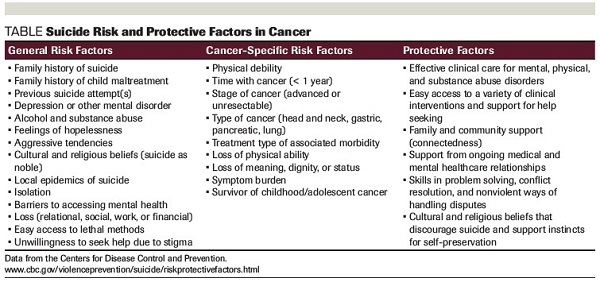
We often tell cancer patients to be positive. But they go through a lot of psychological emotions including suicide ideation. It is also important that we are aware of the high rate of suicide among cancer patients. Psycho-oncologist Bincy Mathew sheds light on the signs of suicide and what caregivers and healthcare professionals can do.
According to a SEER database analysis, the suicide rate among the cancer population was found to be 60% higher than the general population or with any other medical conditions (Rahouma, 2017). To be able to prevent such cases, it is important for us to create awareness about the various potential areas of risk in a patient’s journey. Past data suggests that the risk of suicide is the highest right after the cancer diagnosis. It is also quite common among the patients in their advanced stage of cancer. The reason for such incidents is often attributed to the ignorance of psychosocial aspects of the disease despite having shown the psychological symptoms. The suicidal ideation, thoughts, and behaviors can be associated with various psychosocial factors such as severe pain, impulsivity, family history of suicides, pessimism/hopelessness, lack of emotional support, delirium, and guilt of burdening the family and/or low spirituality. Sometimes, the exacerbation of psychiatric conditions can bring about suicidal ideation among people with cancer.
Related Reading: Why Cancer Patients Need Counselling
The rate and number of suicidal attempts are found to be different in different types of cancers. For example, certain cancers like lung, prostate, and head & neck cancers are associated with higher rates of suicides than other cancers, irrespective of the stage of cancer and intent (curative/palliative) of treatment. For instance, patients who get cancer and have a history of tobacco and alcohol use, focus on it as a self-inflicted injury which then leads to feelings of guilt, shame, and self-blame, all of which may push them into suicidal ideation consequently.
I have put together some helpful tips for the caregivers and family members who are helping their loved ones during their tough journey with cancer. As I always emphasize, whether suicidal or not, we must not ever ignore the psychological side of the patient when going through the treatment for better results and even better quality of life. The suicidal ideations get more reinforced for those cancer patients who have financial obligations.
Signs and Symptoms among Cancer Patients
If you can identify the signs early on, suicide is preventable among cancer patients. One must watch out for patients talking about killing themselves, lamenting about reasons to live, dwelling on their self-worth and so forth. These are some of the warning signs to look for. Few other signs seen among the patients are a behavior of threatening to kill oneself, browsing on the internet about various ways to die, self-harming, drastic mood swings, and complete social withdrawal etc. Additionally, listed below are other common contributing factors responsible for suicidal ideation among cancer patients.
Prior psychiatric history: Studies indicate that a patient who has a history of depression and/or anxiety is more vulnerable to commit suicide.
Prior suicide attempts: It is considered as a clinically relevant predictor of suicidal behavior. After failed attempts, the risk of repetition of the same behavior is often found in many patients.
Expressing a feeling of burdening the family: When there is less support from family, patients often consider themselves a burden to their own family. However, in certain cases, even when the family is very supportive, the patients take the guilt on themselves for bringing unexpected emotional and financial disturbances to their loved ones.
Physical symptoms, especially severe pain: As we know, many cancers cause severe and unimaginable pain to the patients. Pain often tests mental and physical thresholds of patients. Many patients hide their pain from loved ones thinking that would only burden them further, and in order to escape it resort to extreme steps like suicide.

Preventive Measures and Recommendations
Whether you are a family member or a caregiver, once you have identified the symptoms, you must not waste any time in taking right interventions to help the patient. This includes immediately informing the primary physician, and getting appropriate help from a Mental Health Professional. Such steps can prove to be effective, and are highly recommended.
Unfortunately in many cases, even identifying the warning signs correctly and referring the patient to a Mental Health Practitioner at the right time is not yet a norm, especially in developing countries like India. As healthcare professionals, below are some of the steps we can take

(Aboumrad, 2018)
Conclusion
While communicating with cancer patients, always try to bring positive energy and be very gentle, but please ASK about their emotional concerns. One of the challenges of our healthcare system is that it limits the time that the doctor spends with each patient in understanding their emotional wellbeing. These duties are often offloaded to untrained hospital staff.
Be it a professional or a caregiver, the right method is to actively LISTEN. Listen to the patients without interrupting. Encourage them to express their feelings and open up. It is okay to have long pauses and silence while engaging in a conversation with patients. A psychologist or psycho-oncologist is trained to bring the best out in such cases but it is important to have this awareness spread among the general public.
In cases of patient who have been identified as high-risk, follow these suggestions:
- Do not leave them alone and ensure them that you are always there to help.
- Ensure the place is safe and they do not have any access or means with which they can aid themselves to take any tragic steps.
- Remove objects such as knives, blades ropes etc. from their place of stay.
- Document their ideation in their file and inform their physician, assigned nursing staff and family members immediately.
References
Rahouma M, Kamel M, Nasar A, et al. Among all cancers, lung cancer appears to put patients at greatest suicide risk. Am J Respir Crit Care Med. 2017; 195.
Aboumrad, M., Shiner, B., Riblet, N., Mills, P. D., & Watts, B. V. (2018). Factors contributing to cancer‐related suicide: A study of root‐cause analysis reports. Psycho‐Oncology.
Adapted from a previous Linkedin post with permission from Bincy Mathew






